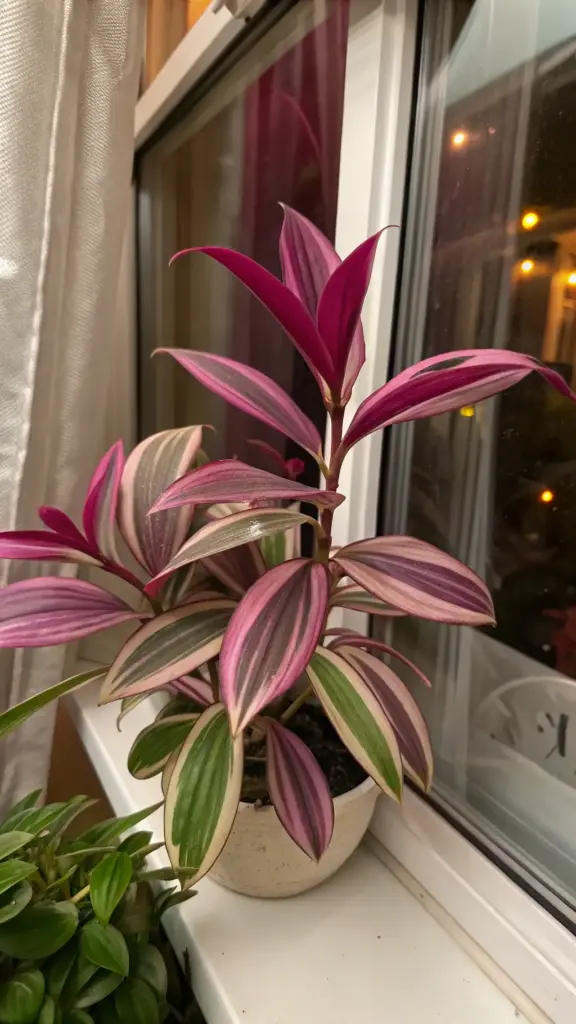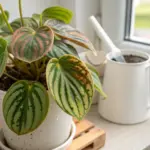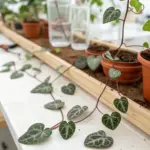2. The Temperature Trick That Intensifies Pink Hues

I stumbled onto this temperature secret completely by accident during a particularly cold October night. My heating system broke, and I was panicking about my plants surviving the chilly 60°F house.
Three weeks later, my Nanouk looked absolutely stunning. The pink stripes were more vibrant than I’d ever seen them, and I couldn’t figure out why.
That’s when I discovered the magic of temperature fluctuations for color enhancement.
Why Your Plant Loves Cool Nights (And You Should Too)
Here’s the science that blew my mind: anthocyanin production actually increases when plants experience cooler nighttime temperatures. It’s like nature’s way of protecting the plant from potential frost damage.
Think of it as your plant putting on a colorful winter coat. The cooler it gets at night, the more pink pigments it produces.
I started tracking my home temperatures obsessively after this discovery. My digital thermometer became my best plant parent tool.
The difference between 70°F nights and 62°F nights was honestly dramatic. Those cooler evenings triggered so much more pink pigmentation that my plant looked like a completely different variety.
The Magic Temperature Formula That Actually Works
After months of experimenting, I found the sweet spot: 65-75°F during the day and 60-65°F at night. This 10-15 degree difference is what creates those jaw-dropping colors.
Don’t go below 55°F though. I learned this the hard way when my overzealous temperature control nearly killed my favorite cutting.
Room temperature during the day keeps your plant happy and growing. But those cooler nighttime temperatures are where the magic happens for color development.
I use a programmable thermostat to create these fluctuations automatically. Best$40 I ever spent for my plant collection.
Creating Temperature Drama in Modern Homes
Most of us live in climate-controlled spaces that stay the same temperature 24/7. Your HVAC system is actually working against those gorgeous Nanouk colors.
My first hack was moving my plant away from heating vents. Those constant warm air blasts were keeping nighttime temperatures too high.
Strategic plant placement became my obsession. I found spots near exterior walls that naturally cool down more at night.
Opening windows for just 30 minutes before bed during fall and spring months made a huge difference. That natural temperature drop triggered incredible color responses.
Seasonal Adjustments That Keep Colors Popping
Winter temperature management is tricky because most homes get super dry and warm from heating systems. I learned to embrace slightly cooler indoor temperatures during plant season.
Spring is honestly the easiest time for color enhancement. Natural temperature fluctuations do most of the work for you.
Summer is the biggest challenge. Air conditioning keeps everything too consistent, so I had to get creative with fans and strategic cooling.
I actually move my Nanouk to my basement during heat waves. It stays about 5-8 degrees cooler down there, and the colors stay vibrant all summer long.
Fan Strategies That Actually Work
Ceiling fans became my secret weapon for creating temperature variations. Running them on low speed during the day helps with air circulation and slight cooling.
I position a small oscillating fan about 6 feet from my plant during hot afternoons. Not blowing directly on it – that causes stress – but creating gentle air movement.
The key is consistent air circulation without creating drafts. Your plant wants gentle breezes, not hurricane-force winds.
Night ventilation with fans pulling cool air in through windows works amazingly well during transitional seasons.
Red Flags Your Temperature Game is Wrong
Heat stress shows up as faded colors and droopy leaves, even when the soil is perfectly moist. I used to think this was a watering issue until I started monitoring temperatures.
Leaves turning completely green during summer months? That’s usually too much consistent warmth without nighttime cooling.
Cold damage looks different – you’ll see black or brown spots on leaves, especially the pink areas. Those pigmented sections are actually more sensitive to extreme cold.
Sudden temperature changes stress plants out more than gradual shifts. I learned to make adjustments slowly over several days rather than shocking my plants.
My Biggest Temperature Mistakes (So You Don’t Make Them)
I once put my Nanouk outside during a 45°F night thinking cooler was always better. Wrong. The leaves got damaged, and it took months to recover.
Drafty windows seemed like a good idea for temperature variation until I realized the constant air movement was actually stressing the plant.
Placing plants near radiators or heating vents for “consistent warmth” completely backfired. Those hot spots prevented the natural cooling that triggers color production.
The biggest lesson? Gradual, consistent temperature patterns work better than dramatic swings.
Now that you’ve mastered the temperature dance, it’s time to learn about the strategic watering technique that can make or break your color game. There’s actually a “stress watering” method that intensifies variegation – but get it wrong, and you’ll lose those gorgeous hues forever! Hit “next” to discover this game-changing watering secret.









GIPHY App Key not set. Please check settings